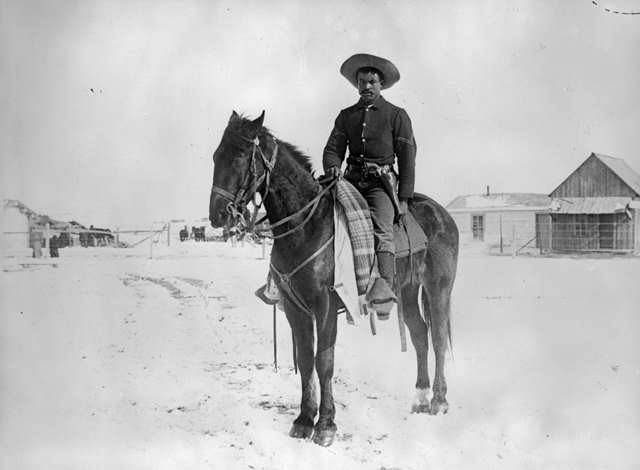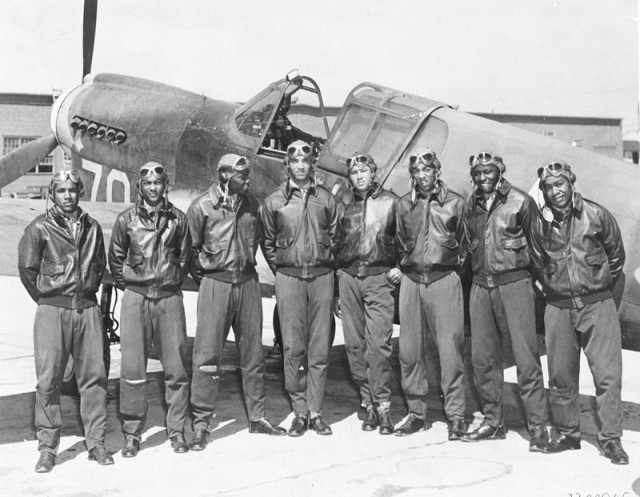The term “Buffalo Soldier” refers to African-American soldiers that served in the US Army. At first, the African-Americans fought in the late stages of the American-Indian wars that raged between European settlers and Native Americans since the first colonization attempts in circa 1600. The confrontations lasted until 1924, when the Apache War officially ended, closing a long and bloody chapter of the American history.
On September 21, 1866, the 10th Cavalry Regiment was assembled as an “all-black” unit. This date represents the founding of the so-called Buffalo Soldier regiments. The American Civil War first saw African-Americans fighters who were organized in regiments called the United States Colored Troops. The men fought bravely against the Confederation, for their freedom against the slave owners. When the 10th Cavalry Regiment was formed, three more regiments followed: the 9th Cavalry and the 24th and 25th Infantry.
It is still a subject of debate, how exactly did the name “Buffalo Soldiers” occur. There are several versions of the story, but they all agree on one thing ― the name was given by the Indians. According to the Buffalo Soldiers National Museum, the name originated with the Cheyenne warriors in the winter of 1877, the actual Cheyenne translation being “Wild Buffalo”. However, writer Walter Hill documented the account of Colonel Benjamin Grierson, who founded the 10th Cavalry regiment, recalling an 1871 campaign against Comanches.
Hill came to the conclusion following Grierson’s assertions that it was the appearance of African-American soldiers, more precisely, their curly hair that has contributed to the name, as the men looked like Bisons to the Indians. Some sources assert that the nickname was given out of respect for the fierce fighting ability of the 10th Cavalry. Still other sources point to a combination of both legends.
![Attack of the Seminoles on the blockhouse in December 1835. By Charleston, S.C. : T.F. Gray and James - Transferred from [1], Public Domain.](https://www.warhistoryonline.com/wp-content/uploads/sites/64/2016/05/800px-Attackblockhouse-640x460.png)
Besides serving in the Indian-American campaign, the Buffalo Soldiers were involved in all major conflicts concerning the US throughout the 19th and 20th century. In 1898, the men served their country in the American-Spanish War with 5,000 volunteers within the Buffalo Soldier’s ranks. They fought in Cuba, in the Battle of San Juan Hill, when Cuba sought independence from Spain and was backed by the US. After this short campaign, the African-American soldiers fought in the Philipines, also breaking the colonial chains of the decaying Spanish Empire.

During the Mexican-American Border War in 1918, elements of the 10th Cavalry Regiments fought alongside the 35th Infantry Regiment with great success. They were most notably engaged in the Battle of Ambos Nogales, after which a ceasefire was arranged and a permanent border was established in Ambos Nogales. This was a large US military victory and the members of the 10th Cavalry Regiment once again confirmed their elite status.
Buffalo soldiers fought in the last larger engagement of the Indian Wars, the small Battle of Bear Valley in southern Arizona which occurred in 1918 between U.S. cavalry and Yaqui natives. In peacetime condition, the men of the 9th Cavalry Regiment and the 24th Infantry Regiment served as park rangers in California’s Sierra Nevada.
All park rangers before 1899 were white, so this became an important step for the African-American community in the USA. Even though slavery was abolished, racial tensions lingered among the population and in government institutions alike. The Army was no different. Other than having progressive individuals who aligned themselves with the African-American soldiers, demanding equal rights, racial prejudice was often threatening to prevail. The number of African-American cadets in the Military Academies began to increase at the beginning of the 20th century, providing educated leadership that opened new chapters in American military history.
With the US involvement in the late stages of World War I, General John Perching became the commander of the American Expeditionary Forces in Europe. He was a veteran of the Spanish-American War where he saw black soldiers fighting equally as their white counterparts. Pershing advocated the use of African-American soldiers, but racist currents within the elite West Point Academy saw this as an object of ridicule. They nicknamed Pershing “[N-word] Jack”. After the Buffalo Soldiers showed what their worth, the press changed the nickname to “Black Jack”.
During World War I, even Pershing bowed to the racial policies of President Woodrow Wilson, Secretary of War Newton D. Baker, and the southern Democratic Party with its “separate but equal” philosophy. For the first time in American history, Pershing allowed American soldiers (African Americans) to be under the command of a foreign power. The Buffalo Soldiers were allowed to serve under the French flag.

Nevertheless, the boundaries were bent, slowly, but steadily. During the Second World War, a unit of African American airmen was formed. Black pilots fought in WWI under French Air Force and distinguished themselves as worthy opponents in the skies. The US government remained conservative, even though all evidence proved that African Americans were as good as the rest. The Tuskegee Airmen Regiment was given the green light and another step was made towards complete equality within the US Armed Forces.
It was not until the Korean War that the segregation in the Army ended. The Buffalo Soldiers Regiments ― the 10th and 9th Cavalry and the 24th and 25th Infantry were finally integrated into regular army units and for the first in American history black and white fought together.
On September 6, 2005, Mark Matthews, who was the oldest living Buffalo Soldier, died at the age of 111. He was buried at Arlington National Cemetery.
![Buffalo soldiers of the 25th Infantry, some wearing buffalo robes, Ft. Keogh, Montana. By Chr. Barthelmess - Library of Congress CALL NUMBER: Unprocessed in PR 13 CN 1995:113.274 [item] [P&P]This image is available from the United States Library of Congress's Prints and Photographs division under the digital ID cph.3g06161. Buffalo soldiers of the 25th Infantry, some wearing buffalo robes, Ft. Keogh, Montana. By Chr. Barthelmess - Library of Congress CALL NUMBER: Unprocessed in PR 13 CN 1995:113.274 [item] [P&P]This image is available from the United States Library of Congress's Prints and Photographs division under the digital ID cph.3g06161.](https://www.warhistoryonline.com/wp-content/uploads/sites/64/2016/05/1280px-Buffalo_soldiers1.jpg)